VAUXHALL MOVANO_B 2020 Manual Online
Manufacturer: VAUXHALL, Model Year: 2020, Model line: MOVANO_B, Model: VAUXHALL MOVANO_B 2020Pages: 351, PDF Size: 9.32 MB
Page 81 of 351
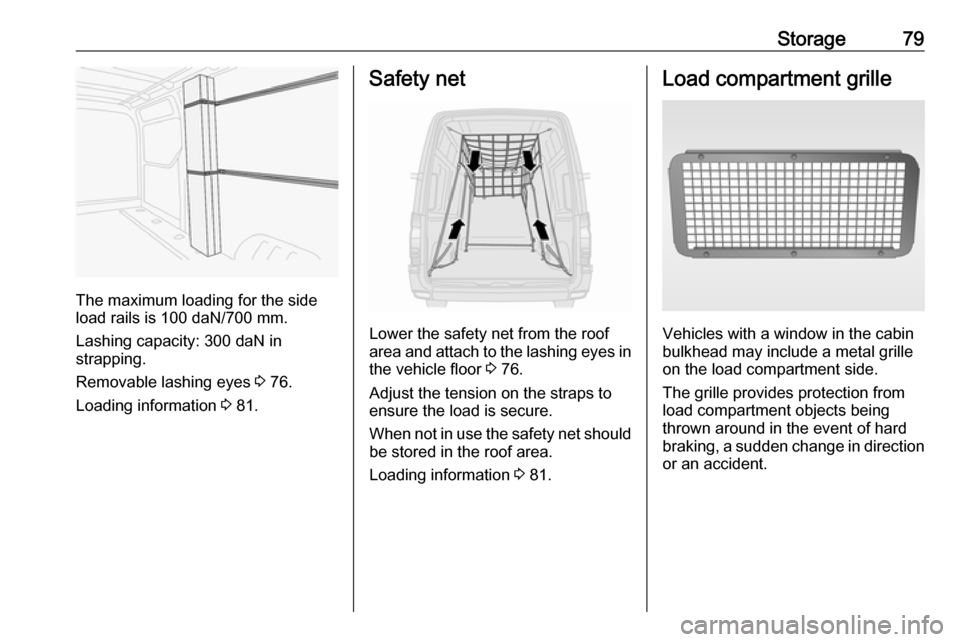
Storage79
The maximum loading for the side
load rails is 100 daN/700 mm.
Lashing capacity: 300 daN in
strapping.
Removable lashing eyes 3 76.
Loading information 3 81.
Safety net
Lower the safety net from the roof
area and attach to the lashing eyes in the vehicle floor 3 76.
Adjust the tension on the straps to
ensure the load is secure.
When not in use the safety net should be stored in the roof area.
Loading information 3 81.
Load compartment grille
Vehicles with a window in the cabin
bulkhead may include a metal grille
on the load compartment side.
The grille provides protection from
load compartment objects being
thrown around in the event of hard
braking, a sudden change in direction or an accident.
Page 82 of 351
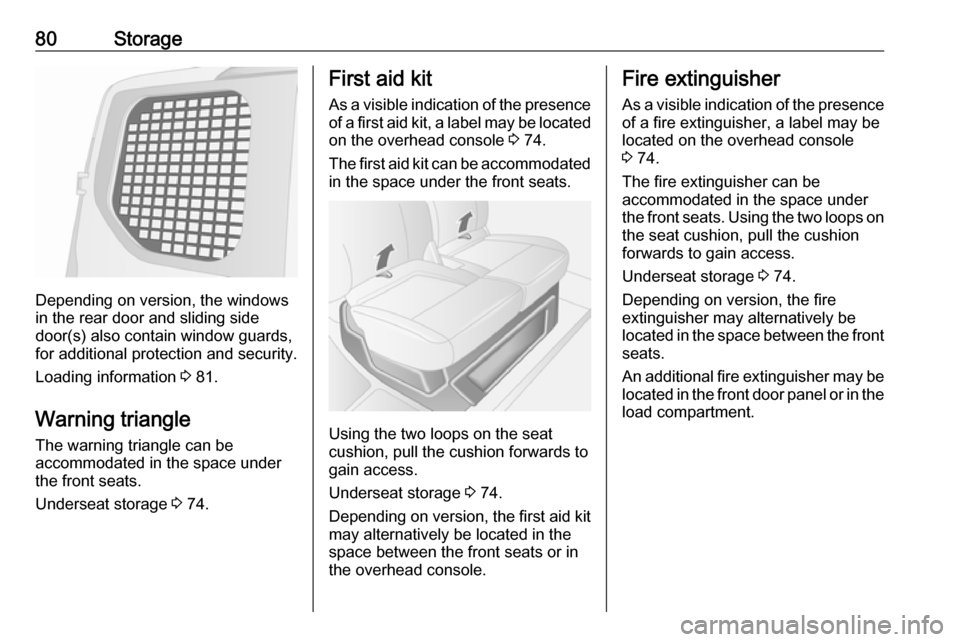
80Storage
Depending on version, the windows
in the rear door and sliding side
door(s) also contain window guards,
for additional protection and security.
Loading information 3 81.
Warning triangle
The warning triangle can be
accommodated in the space under
the front seats.
Underseat storage 3 74.
First aid kit
As a visible indication of the presence
of a first aid kit, a label may be located on the overhead console 3 74.
The first aid kit can be accommodated
in the space under the front seats.
Using the two loops on the seat
cushion, pull the cushion forwards to
gain access.
Underseat storage 3 74.
Depending on version, the first aid kit may alternatively be located in the
space between the front seats or in
the overhead console.
Fire extinguisher
As a visible indication of the presence
of a fire extinguisher, a label may be
located on the overhead console
3 74.
The fire extinguisher can be
accommodated in the space under
the front seats. Using the two loops on the seat cushion, pull the cushion
forwards to gain access.
Underseat storage 3 74.
Depending on version, the fire
extinguisher may alternatively be
located in the space between the front
seats.
An additional fire extinguisher may be
located in the front door panel or in the load compartment.
Page 83 of 351

Storage81Roof rack system
Roof rack For safety reasons and to avoiddamage to the roof, the vehicle
approved roof rack system is
recommended.
Follow the installation instructions
and remove the roof rack when not in
use.Loading information
● Heavy objects in the load compartment should be evenlydistributed and placed as far
forward as possible. If objects
can be stacked, the heavier
objects should be placed at the
bottom.
● Secure objects with lashing straps attached to lashing eyes
3 76.
● Secure objects into position or prevent loads from sliding
excessively by attaching optional cargo management features to
the load rails using removable
lashing eyes.
Cargo management system
3 77.
● Secure loose objects in load compartment to prevent them
from sliding.
● The load must not obstruct the operation of the pedals, parking
brake and gear selector lever, orhinder the freedom of movement of the driver. Do not place any
unsecured objects in the interior.
● Do not drive with an open load compartment. In addition, the
number plate is only
distinguishable and illuminated correctly if the doors are closed.9 Warning
Always make sure that the load in
the vehicle is securely stowed.
Otherwise objects can be thrown
around inside the vehicle and
cause personal injury or damage
to the load or vehicle.
● The payload is the difference between the permitted gross
vehicle weight (see identification
plate 3 314) and the EC kerb
weight.
To calculate the payload, enter
the data for your vehicle in the
Weights table at the front of this
manual.
The EC kerb weight includes
weights for the driver (68 kg),
Page 84 of 351

82Storageluggage (7 kg) and all fluids (fuel
tank 90% full).
Optional equipment and
accessories increase the kerb
weight.
● Driving with a roof load increases
the sensitivity of the vehicle to
cross-winds and has a
detrimental effect on vehicle
handling due to the vehicle's
higher centre of gravity.
Distribute the load evenly and secure it properly with retaining
straps. Adjust the tyre pressure
and vehicle speed according to
the load conditions. Check and
retighten the straps frequently.
Do not drive faster than 75 mph.
● The permissible roof load (which includes the weight of the roof
rack) is 200 kg for standard roof
variants. The roof load is the combined weight of the roof rack
and the load.
Page 85 of 351

Instruments and controls83Instruments and
controlsControls ....................................... 84
Steering wheel adjustment ........84
Steering wheel controls .............84
Horn ........................................... 84
Steering column controls ...........84
Windscreen wiper and washer ..85
Outside temperature ..................86
Clock ......................................... 87
Power outlets ............................. 87
Inductive charging .....................89
Cigarette lighter ......................... 90
Ashtrays .................................... 90
Warning lights, gauges and indi‐ cators ........................................... 90
Instrument cluster ......................90
Speedometer ............................. 90
Odometer .................................. 91
Trip odometer ............................ 91
Tachometer ............................... 91
Fuel gauge ................................ 92
AdBlue gauge ............................ 92
Engine coolant temperature gauge ....................................... 92
Service display .......................... 93Transmission display .................93
Control indicators ......................94
Turn lights .................................. 97
Seat belt reminder .....................97
Airbag and belt tensioners .........97
Airbag deactivation ....................97
Charging system .......................98
Malfunction indicator light ..........98
Service vehicle soon .................98
Stop engine ............................... 99
Brake system ............................. 99
Parking brake ............................ 99
Antilock brake system (ABS) .....99
Gear shifting .............................. 99
Variable effort steering ..............99
Lane departure warning ..........100
Electronic Stability Control ......100
Engine coolant temperature ....100
Preheating ............................... 100
AdBlue ..................................... 100
Tyre pressure monitoring system .................................... 101
Engine oil pressure ..................101
Low fuel ................................... 102
Stop-start system ....................102
Exterior light ............................ 102
Low beam ................................ 102
High beam ............................... 102
High beam assist .....................102
Front fog lights ......................... 102Rear fog light........................... 102
Cruise control .......................... 102
Active emergency braking .......103
Speed warning ........................ 103
Speed limiter ........................... 103
Tachograph ............................. 103
Door open ................................ 103
Displays ..................................... 104
Driver Information Centre ........104
Info Display .............................. 104
Vehicle messages ......................105
Warning chimes .......................106
Trip computer ............................. 107
Tachograph ................................ 108
Page 86 of 351
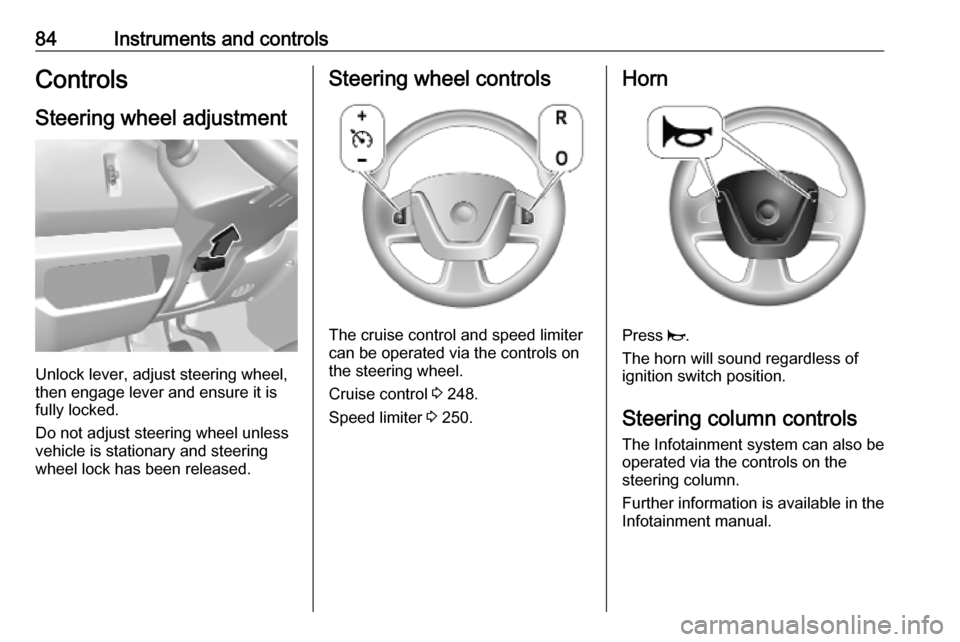
84Instruments and controlsControlsSteering wheel adjustment
Unlock lever, adjust steering wheel,
then engage lever and ensure it is
fully locked.
Do not adjust steering wheel unless
vehicle is stationary and steering
wheel lock has been released.
Steering wheel controls
The cruise control and speed limiter
can be operated via the controls on
the steering wheel.
Cruise control 3 248.
Speed limiter 3 250.
Horn
Press j.
The horn will sound regardless of
ignition switch position.
Steering column controls The Infotainment system can also be
operated via the controls on the
steering column.
Further information is available in the
Infotainment manual.
Page 87 of 351

Instruments and controls85Windscreen wiper and
washer
Windscreen wiper0:offP /AUTO:timed interval wiping or
automatic wiping with
rain sensor1:slow2:fast
Do not use if the windscreen is frozen.
Switch off in car washes.
Notice
During driving, wiper speed is
reduced automatically when the
vehicle is at a standstill. As soon as
the vehicle starts to move, wiping
returns to the selected speed unless the lever has been moved.
Adjustable delay of timed interval
wipingP:timed interval wiping
Turn the adjuster wheel to adjust the
delay between wipes:
longer delay:turn adjuster
wheel downwardsshorter delay:turn adjuster
wheel upwardsAutomatic wiping with rain sensorAUTO:automatic wiping with rain
sensor
The rain sensor detects the amount of water on the windscreen and
automatically regulates the frequency
of the windscreen wipers.
Notice
During extreme weather conditions,
e.g. fog or snow, automatic wiping
with rain sensor may become
unavailable. If required, select
another wiper position.
Adjustable sensitivity of the rain
sensor
Page 88 of 351
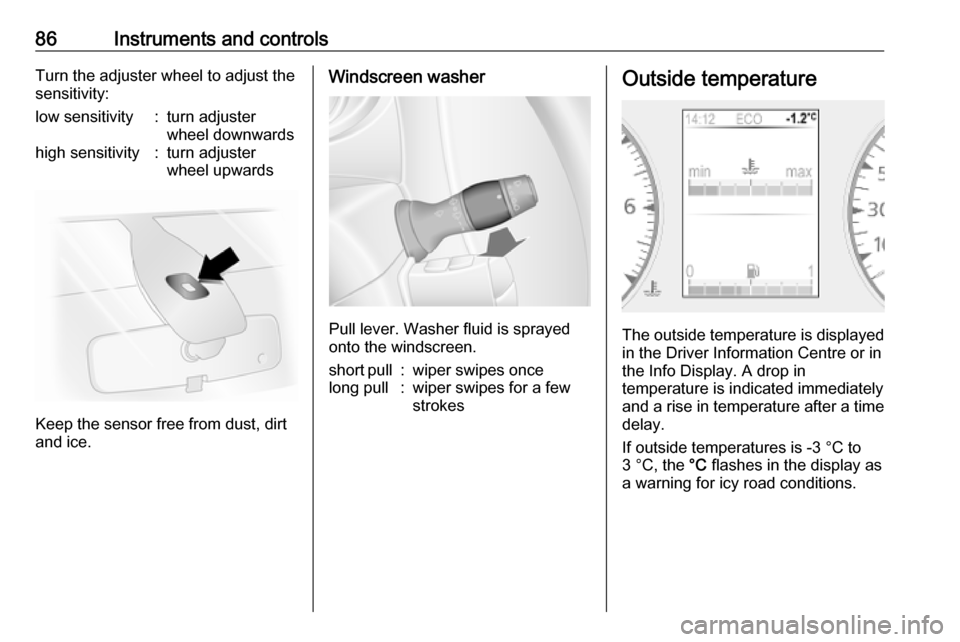
86Instruments and controlsTurn the adjuster wheel to adjust the
sensitivity:low sensitivity:turn adjuster
wheel downwardshigh sensitivity:turn adjuster
wheel upwards
Keep the sensor free from dust, dirt
and ice.
Windscreen washer
Pull lever. Washer fluid is sprayed
onto the windscreen.
short pull:wiper swipes oncelong pull:wiper swipes for a few
strokesOutside temperature
The outside temperature is displayed
in the Driver Information Centre or in
the Info Display. A drop in
temperature is indicated immediately
and a rise in temperature after a time
delay.
If outside temperatures is -3 °C to
3 °C, the °C flashes in the display as
a warning for icy road conditions.
Page 89 of 351
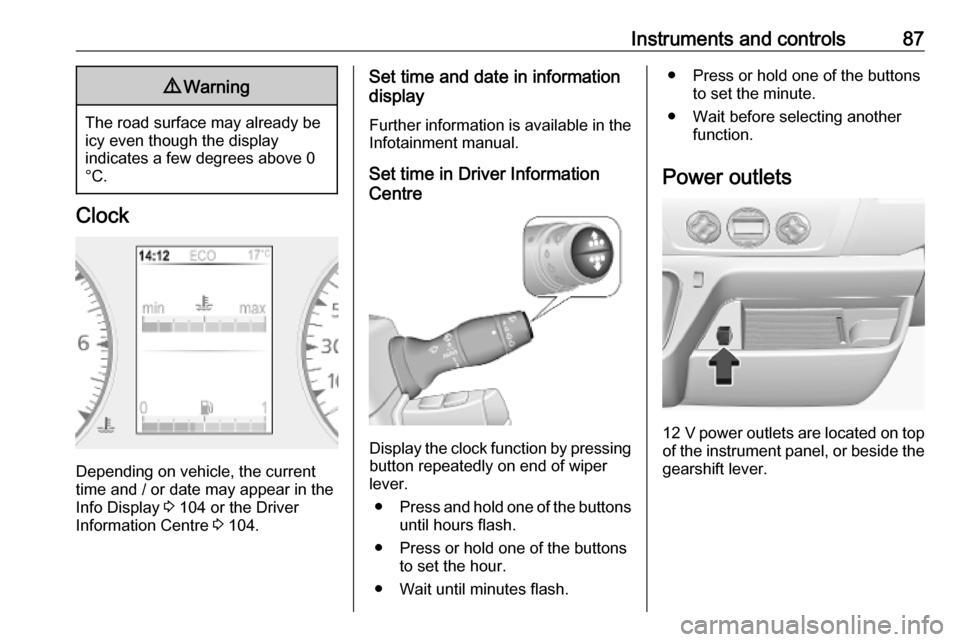
Instruments and controls879Warning
The road surface may already be
icy even though the display
indicates a few degrees above 0
°C.
Clock
Depending on vehicle, the current
time and / or date may appear in the
Info Display 3 104 or the Driver
Information Centre 3 104.
Set time and date in information
display
Further information is available in the
Infotainment manual.
Set time in Driver Information
Centre
Display the clock function by pressing button repeatedly on end of wiper
lever.
● Press and hold one of the buttons
until hours flash.
● Press or hold one of the buttons to set the hour.
● Wait until minutes flash.
● Press or hold one of the buttons to set the minute.
● Wait before selecting another function.
Power outlets
12 V power outlets are located on top
of the instrument panel, or beside the gearshift lever.
Page 90 of 351
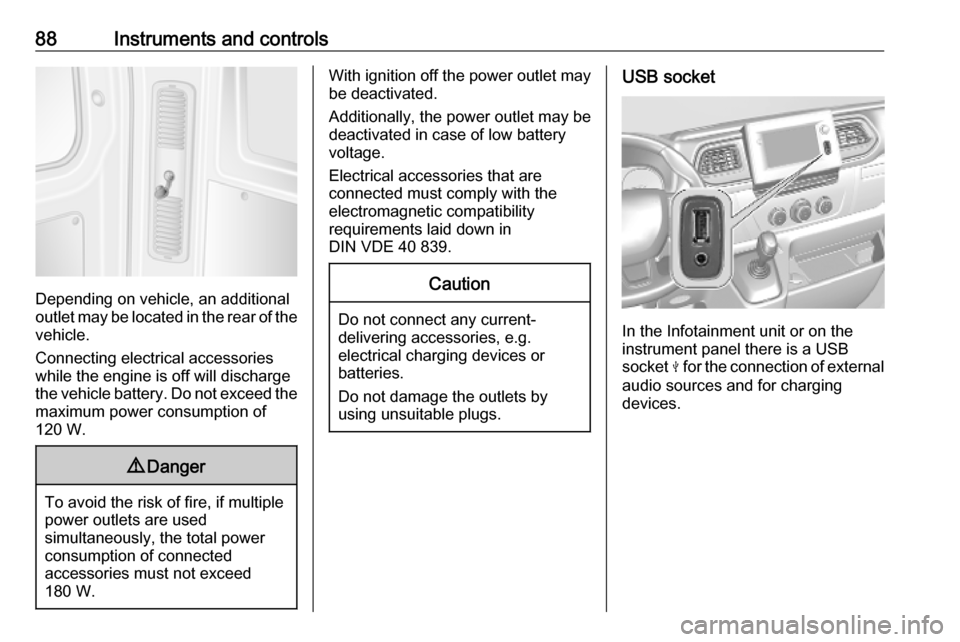
88Instruments and controls
Depending on vehicle, an additional
outlet may be located in the rear of the
vehicle.
Connecting electrical accessories
while the engine is off will discharge
the vehicle battery. Do not exceed the
maximum power consumption of
120 W.
9 Danger
To avoid the risk of fire, if multiple
power outlets are used
simultaneously, the total power
consumption of connected
accessories must not exceed
180 W.
With ignition off the power outlet may
be deactivated.
Additionally, the power outlet may be
deactivated in case of low battery
voltage.
Electrical accessories that are
connected must comply with the
electromagnetic compatibility
requirements laid down in
DIN VDE 40 839.Caution
Do not connect any current- delivering accessories, e.g.
electrical charging devices or
batteries.
Do not damage the outlets by
using unsuitable plugs.
USB socket
In the Infotainment unit or on the
instrument panel there is a USB
socket M for the connection of external
audio sources and for charging
devices.